An adventure on the Agatsuma Line, the “hot spring” line of Gunma!
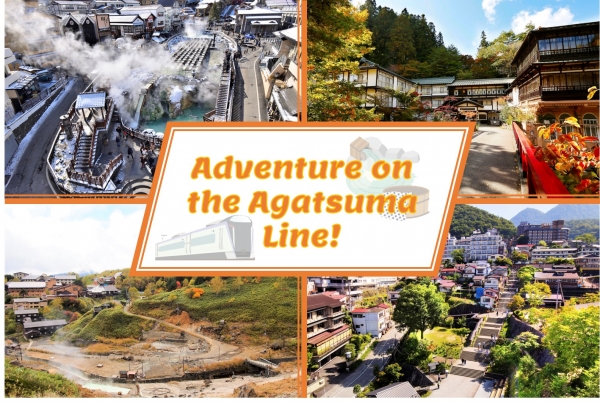
Do you love hot springs (温泉 onsen)? They are one of the main draws for visitors flocking to Japan each year, and although they can be found in many areas around the country, one particular prefecture famous for hot springs is Gunma (群馬県 Gunma-ken). The landlocked prefecture is home to several amazing hot springs, but what’s more, there is one train line that will bring visitors close to them.
The Agatsuma Line (吾妻線 Agatsuma-sen) is a train line that traverses the valleys of Gunma and follows the Agatsuma River. With a total length of 55.6km, it connects JR Ōmae Station (JR大前駅) and JR Shibukawa Station (JR渋川駅), and trains on the line also run through the Jōetsu Line (上越線 Jōetsu-sen) to/from JR Takasaki Station (JR高崎駅 Takasaki-eki). The Agatsuma Line is known for the number of hot springs located near its route, so if you’re visiting a hot spring town in Gunma, chances are you can access it via this line!

Location of Agatsuma Line. (Image credit: Google Maps)

Map of Agatsuma Line and the surrounding hot spring towns. (Image credit: Google Maps)
For this article, we are exploring the “hot spring” line and the hot spring towns that are located nearby, and we shall discover the beauty of the prefecture’s seasons and nature along the way. If you love riding trains and soaking in hot spring baths, then this article is for you.
A train ride to Gunma’s famous hot springs

The 211 series (left) and 651 series (right) trains that run on the Agatsuma Line. (Image credit: photoAC (left), JR East (right))
As mentioned earlier, the Agatsuma Line is noted for its access to a number of Gunma’s beloved hot springs. The trains that run on the line are the 211 series, which is used for the ordinary train service, and the 651 series, which is used for the Limited Express Kusatsu train service that runs between JR Ueno Station (JR上野駅 Ueno-eki) in Tokyo and JR Naganoharakusatsuguchi Station (JR長野原草津口駅 Naganoharakusatsuguchi-eki). Thanks to this limited express train service, Tokyo dwellers can reach Gunma’s hot springs directly. How convenient is that!
Visitors can hop on the train and get off at selected stations to visit the many hot springs located close to the line. Let’s explore these stations, and check out the hot springs that you can visit from each of them.
① JR Shibukawa Station (JR渋川駅)

JR Shibukawa Station. (Image credit: photoAC)
First up on the Agatsuma Line is JR Shibukawa Station. Originally built in 1921, the station is a terminus on one end of the line, with JR Ōmae Station on the other. Visitors can get off here when they are heading to one of Gunma’s most loved hot spring towns.
Ikaho Onsen (伊香保温泉)

Ikaho Onsen. (Image credit: ©JNTO)
Just a 20-minute bus ride away from JR Shibukawa Station is Ikaho Onsen, which is often regarded as one of the top four hot spring towns of Gunma, with the other three being Kusatsu Onsen, Shima Onsen (四万温泉), and Minakami Onsen (水上温泉). Tucked away in the mountains of Gunma, the traditional hot spring town has a long history that dates back to the 9th century, and is loved by many visitors for its cosy ambience.

Ikaho Onsen’s iconic stone steps. (Image credit: ©JNTO)
What’s unique about Ikaho Onsen is that it is built on the slopes of Mount Haruna (榛名山 Haruna-san). Upon reaching the town, visitors will come across a flight of stone steps stretching approximately 300m that leads up to the town centre. Built in 2010, the stone steps have become part of Ikaho Onsen’s identity, and a cherished landmark among visitors.
Here’s a tip: don’t just climb the steps in a haste. Take your time to observe the different writings engraved on them, such as poems from Yosano Akiko (与謝野晶子), and wishes for prosperity for the town. There are 365 steps altogether, and one of them even states “I want the hot spring town to become crowded 365 days a year”!

Ikaho Onsen’s renowned hot spring water. (Image credit: photoAC)
If there’s one thing that Ikaho Onsen is famous for, it’s the hot spring water, which is rich in iron and minerals, and is known for its healing properties. There are two different sources of the hot spring water: one is Kogane-no-Yu (黄金の湯 Golden Water, known for its reddish-brown iron-rich water, and the other is Shirogane-no-Yu (白金の湯 Silver Water), which is more transparent.
Try the hot spring waters and feel the difference yourself; you can learn how the different waters can have different effects on your body firsthand!

Ikaho Matsuri. (Image credit: ググっとぐんま写真館)
Want to witness a local festival? Then you will be glad to know that Ikaho Onsen has its own festival named the Ikaho Matsuri (伊香保まつり), which is held from 18 to 20 September every year. During this period, visitors will get to see participants hauling 11 taru-mikoshi (樽神輿 portable shrines made from sake barrels) up the town’s stone steps and towards Ikaho Shrine with others dancing and playing traditional festival music.
It’s an festive spectacle that visitors should not miss, so make sure to catch this festival if you’re in town, especially in September.
Ikaho Matsuri (伊香保まつり)
Dates: 18–20 September
Venue: Ikaho Onsen’s town centre
Access: 10-minute walk from Ikaho Bus Terminal

Kajika Bridge in the summer. (Image credit: ©JNTO)
While exploring Ikaho Onsen, why not venture out to see other scenic spots? Just south of the hot spring town’s centre is Kajika Bridge (河鹿橋 Kajika-bashi), a lacquered vermillion bridge that is surrounded by Shibukawa’s pristine nature. The bridge is highly popular among visitors for its picturesque landscape, and becomes a magnificent sight especially in autumn.

Kajika Bridge illuminated at night. (Image credit: ググっとぐんま写真館)
From late October to mid-November, the Kajika Bridge Autumn Illumination (河鹿橋紅葉ライトアップ Kajika-bashi kōyō raitoappu) is held when the bridge is lit up at night amidst the red, orange and golden autumn foliage, rendering the entire area simply magical. Be sure to take note of this event if you are in Ikaho Onsen during the season!
Kajika Bridge (河鹿橋)
Address: Ikaho, Ikaho-machi, Shibukawa, Gunma 377-0102
Access: 15-minute walk from Ikaho Onsen’s town centre

Mizusawa Kannon. (Image credit: ググっとぐんま写真館)
Want to take a short excursion from Ikaho Onsen? Take a short local bus ride and head over to Mizusawa Kannon (水澤観音), a temple that was built over 1,300 years ago. It is built to worship Kannon, the Goddess of Mercy, and is a popular tourist spot among visitors to Ikaho Onsen. The intricate designs and animal carvings found on the temple buildings are a marvel to behold, and you will feel like time has stopped when having a stroll on the temple grounds.

Mizusawa udon. (Image credit: ©JNTO)
Do you know what’s famous near the temple? Udon! Mizusawa Kannon is a short walk from Mizusawa Udon Street (水沢うどん街道 Mizusawa Udon-kaidō), where the street is lined with numerous shops selling Mizusawa udon, a local specialty in Shibukawa. The udon is famed for its chewy texture, and is usually served cold with sesame and soya sauces for dipping.
Mizusawa udon is also regarded as one of the three famous types of udon in Japan, alongside Kagawa Prefecture’s Sanuki udon and Akita Prefecture’s Inaniwa udon. Why don’t you try this popular local dish the next time you’re travelling to Ikaho Onsen?
Mizusawa Kannon (水澤観音)
Address: 214 Mizusawa, Ikaho-machi, Shibukawa-shi, Gunma 377-0103
Access: 10-minute bus ride by *Kan-etsu Kotsu bus from Ikaho Onsen / 35-minute bus ride from JR Shibukawa Station
(*Note: The bus service is not covered by JR East Passes.)
Ikaho Onsen (伊香保温泉)
Address: Ikaho, Ikaho-machi, Shibukawa-shi, Gunma
Access: 25-minute bus ride by *Kan-etsu Kotsu from JR Shibukawa Station
(*Note: The bus service is not covered by JR East Passes.)
② JR Nakanojō Station (JR中之条駅)
Next, we move on to JR Nakanojō Station. It is a modest railway station with three platforms where only two are in use, and here is where visitors can get off to head to not one but two hot spring towns in the area.
Shima Onsen (四万温泉)

Shima Onsen in summer (left) and autumn (right). (Image credit: ググっとぐんま写真館)
JR Nakanojō Station is the stop for visitors to get off and head to Shima Onsen, which is the second of the top four hot spring towns of Gunma. It is also one of the oldest hot spring towns in Japan, and its name “四万” (yon-man = shima) means forty thousand, as it is said that bathing in its mineral-rich hot spring water can cure up to 40,000 ailments!

Sekizenkan in Shima Onsen. (Image credit: ©JNTO)
The town has a number of hot spring inns, each offering its own unique hot spring baths and brand of hospitality, but do you know that there is an inn here that is said to have inspired the main setting for the critically acclaimed Studio Ghibli movie “Spirited Away” (千と千尋の神隠し Sen to Chihiro no Kamikakushi)? Sekizenkan (積善館) is a hot spring inn in Shima Onsen that has been patronised by many dignitaries and famous writers over the years, and it is often said to be one of the models for the bathhouse where protagonist Chihiro was forced to work at in the animated movie. Visitors to Sekizenkan have mentioned that they were reminded of the movie while walking through the inn’s hallways, and the resemblance between Sekizenkan and the bathhouse in the movie becomes more prominent at night when the former is lit up to make for an imposing sight.

Sekizenkan at night. (Image credit: photoAC)
The inn is made up of three buildings—the main building, the Sansō (山荘) building, and the Kashōtei (佳松亭) building—and each of them was built at different times in history. The main building, in particular, was originally built in 1691, making it the oldest wooden hot spring inn in Japan.
It also houses Genroku no Yu (元禄の湯), a quaint Romanesque bathhouse built during the Taishō Era. Featuring large arched windows, the bathhouse invokes nostalgia, hearkening back to an era when Western architecture married traditional Japanese design. The main building and the bathhouse have also been designated as an Important Cultural Properties (重要文化財 jūyō-bunkazai).

Genroku no Yu inside Sekizenkan. (Image credit: ©JNTO)
Visitors stepping into the inn would feel like they have travelled back in time, as the buildings exude an old-world atmosphere that has been carefully preserved since their construction. If you’re looking for an unforgettable stay, be sure to take note of this one, especially if you’re a Ghibli fan!
Sekizenkan (積善館)
Address: 4236 Shima-ko, Nakanojo-machi, Agatsuma-gun, Gunma 377-0601
Access: 40-minute bus ride by *Kan-etsu Kotsu from JR Nakanojō Station

Shima Onsen’s natural splendour. (Image credit: ググっとぐんま写真館 (left), ©JNTO (right))
Shima Onsen is renowned not only for its amazing hot spring water, but also for its serene natural atmosphere. With the placid Shima River (四万川) flowing through the rustic town, and surrounded by nature that changes colours according to the season, the town is a gorgeous respite for visitors who would want to get away from the bustling city life.

Lake Okushima. (Image credit: ググっとぐんま写真館)
Want to admire the natural splendour further? Head up north of the town and you will come upon Lake Okushima (奥四万湖 Okushima-ko), a picturesque lake where the Shima River flows from. It is actually a reservoir formed by the Shimagawa Dam, and visitors will be enthralled by the brilliant cobalt blue colour of the lake, which is locally known as “Shima Blue”.

Lake Okushima during autumn (left) and winter (right). (Image credit: ググっとぐんま写真館 (left), photoAC (right))
The lake’s brilliant colour is most pronounced during spring, when the surrounding mountain’s snow melts and flows into it. Coupled with colourful surrounding foliage that changes colours according to the season, the lake looks like it comes straight out of a painting!

Shima Potholes. (Image credit: ググっとぐんま写真館)
Another natural attraction can be found towards the south of Shima Onsen’s town centre. Shima Potholes (四万の甌穴 Shima no Ōketsu) are a group of smooth holes on the riverbed of Shima River. Naturally formed by soil erosion over many years, these formations are a lot more beautiful to see when surrounded by colourful foliage, particularly in autumn.
Shima Potholes (四万の甌穴)
Address: 3520 Shima, Nakanojo-machi, Agatsuma-gun, Gunma 377-0601
Access: 25-minute bus ride by *Kan-etsu Kotsu (関越交通) from JR Nakanojō Station (JR中之条駅)
(*Note: The bus service is not covered by JR East Passes.)
Shima Onsen (四万温泉)
Address: Shima, Nakanojo-machi, Agatsuma-gun, Gunma
Access: 40-minute bus ride by *Kan-etsu Kotsu from JR Nakanojō Station
(*Note: The bus service is not covered by JR East Passes.)
Sawatari Onsen (沢渡温泉)

Sawatari Onsen. (Image credit: ググっとぐんま写真館)
There is another hot spring attraction that can be accessed from JR Nakanojō Station, and that is Sawatari Onsen. Like Shima Onsen, this hot spring retreat is easily accessible with a short bus ride away from the railway station.

Inside a public hot spring bath at Sawatari Onsen. (Image credit: ググっとぐんま写真館)
But unlike Shima Onsen or other more popular hot spring towns near the Agatsuma Line, Sawatari Onsen is quieter and more idyllic, as the town only has a handful of hot spring inns. It is known for its hot spring water rich in minerals such as calcium and sodium sulphate, which are said to have skin-beautifying effects.

One of the several public hot spring baths at Sawatari Onsen. (Image credit: ググっとぐんま写真館)
It is also said that Sawatari Onsen has a history that goes back as far as the Jōmon Period (around 1,000 BC), and that it first opened as a hot spring town in the late 12th century. Since then, it has been visited by many prominent figures and writers throughout different eras, and many visitors have vouched for the town’s warm hospitality and serene ambience.
If you would like a more tranquil and authentic hot spring town for a change, give Sawatari Onsen a try for your next adventure on the Agatsuma Line!
Sawatari Onsen (沢渡温泉)
Address: Kamisawatari, Nakanojō-shi, Agatsuma-gun, Gunma
Access: 20-minute bus ride by *Kan-etsu Kotsu from JR Nakanojō Station
(*Note: The bus service is not covered by JR East Passes.)
③ JR Kawarayu-Onsen Station (JR川原湯温泉)
For our third station, we look at JR Kawarayu-Onsen Station. Originally built in 1946, the station was initially named Kawarayu Station (川原湯駅) but when the Yanba Dam (八ッ場ダム Yanba-damu) was constructed, the train line section between JR Iwashima Station (JR岩島駅) and JR Naganoharakusatsuguchi Station changed course, and Kawarayu Station was relocated to a hill further west of the original spot in 2014. In 1991, the station finally adopted its current name.
Kawarayu Onsen (川原湯温泉)

Kawarayu Onsen Ōyu Kaikan. (Image credit: ググっとぐんま写真館)
The station is the stop for Kawarayu Onsen, a small hot spring town with more than 800 years of history. The town was relocated in 2014, together with the railway station, following the construction of the Yanba Dam. Its concept is to be a “hot spring town where you can walk while gazing at the scenery”, so visitors will be pleasantly surprised by the serenity of the surroundings. The town makes for the perfect place for those seeking a more quiet and peaceful hot spring getaway, and if there is one place they must pay here, it’s the Kawarayu Onsen Ōyu Kaikan (川原湯温泉王湯会館).
Kawarayu Onsen Ōyu Kaikan is a public bathhouse that has been a proud landmark for the locals for generations. Although the original building was remodelled following its relocation, its original entrance design is retained. The hot spring water here is also known to be beneficial for people with rheumatism and joint pain.
Kawarayu Onsen Ōyu Kaikan (川原湯温泉王湯会館)
Address: 234 Kawarayu, Naganohara-cho, Agatsuma-gun, Gunma 377-1302
Access: 20-minute walk from JR Kawarayu-Onsen Station
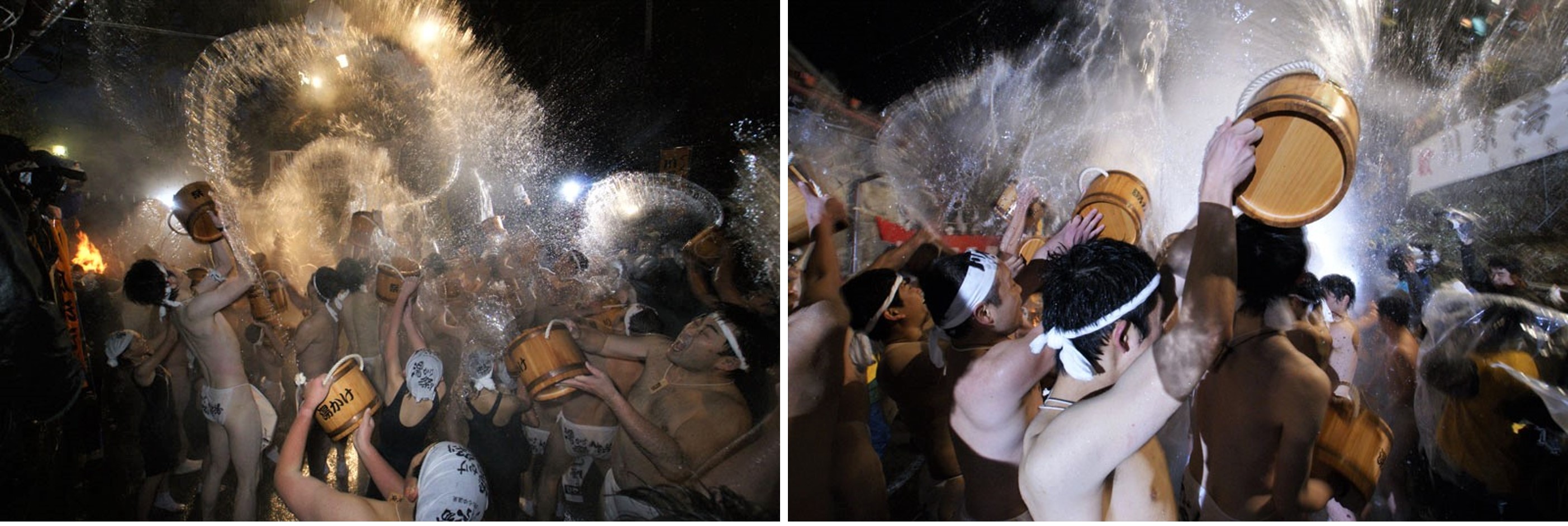
Yukake Matsuri. (Image credit: ググっとぐんま写真館)
Do you know that Kawarayu Onsen is also home to an unusual festival? It is called the Yukake Matsuri (湯かけ祭り), where young men dressed in only loincloths enthusiastically splash hot spring water among themselves. Held at 5am on 20 January every year, this festival’s origins came many years ago when it is said that hot spring water suddenly disappeared. The locals were at a loss, but they could detect a smell resembling boiled chicken eggs, so they sacrificed chickens and prayed, and miraculously the hot spring water returned. Since then, the locals have celebrated a festival from this anecdote.
Imagine seeing people vigorously splashing hot spring water early in the morning in the frigid winter… quite a sight to behold, don’t you think?
Yukake Matsuri (湯かけ祭り)
Date/time: 20 January, 5am
Venue: In front of Kawaryu Onsen Ōyu Kaikan
Access: 20-minute walk from JR Kawarayu-Onsen Station
Kawarayu Onsen (川原湯温泉)
Address: Kawarayu, Naganohara-cho, Agatsuma-gun, Gunma
Access: 20-minute walk from JR Kawarayu-Onsen Station
④ JR Naganoharakusatsuguchi Station (JR長野原草津口駅)

JR Naganoharakusatsuguchi Station. (Image credit: photoAC)
Then, we have the JR Naganoharakusatsuguchi Station, which is perhaps the most prominent railway station on the Agatsuma Line. Built in 1945, the station was originally named Naganohara Station (長野原駅) but changed to the current one in 1991. The current building was also recently constructed in 2013, after the Agatsuma Line was diverted due to the construction of the Yanba Dam.
Kusatsu Onsen (草津温泉)

Kusatsu Onsen. (Image credit: ググっとぐんま写真館)
JR Naganoharakusatsuguchi Station is primarily known as the gateway to Kusatsu Onsen, arguably the most well-known hot spring town in Gunma. Only a short bus ride away from the railway station, the resort is loved by Tokyoites and hot spring lovers everywhere for several reasons, including its charming atmosphere.
Visitors to Kusatsu Onsen will notice the unmistakable smell of sulphur that envelops the whole town. That is due to the town’s highly-prized hot spring water, which is rich in sulphur and minerals that are said to have healing properties. The water is one of the reasons that Kusatsu Onsen is a highly popular tourist attraction that has attracted numerous visitors both local and foreign.

Yutabake in the centre of Kusatsu Onsen. (Image credit: ググっとぐんま写真館)
The centrepiece of Kusatsu Onsen is Yubatake (湯畑), the main outlet of the town’s hot spring water. The hot spring water originates from Mount Shirane (白根山), and it flows to Yubatake before it is distributed to the different hotels and hot spring inns in the town. It is the iconic landmark of Kusatsu Onsen, and it has attracted visitors for generations to this day.

Wooden pipes lined across Yubatake. (Image credit: ググっとぐんま写真館)
Upon reaching the outlet, visitors will also notice several wooden pipes lined across Yubatake. The pipes help to cool down the hot spring water before they are transported to different parts of the town, since the water would be too hot for use when sourced directly from the mountain.

Yubatake after sundown. (Image credit: ググっとぐんま写真館)
Here’s a tip for those visiting Kusatsu Onsen: catch the view of the town at night. When night falls, Yubatake and the whole town will be beautifully illuminated, transforming into a visual spectacle. It is a breathtaking sight that visitors, as well as those spending the night at any of the nearby hotels and hot spring inns, would not want to miss.

Yumomi performance. (Image credit: ©JNTO)
If there is one activity that visitors should catch at Kusatsu Onsen, it is the yumomi (湯もみ), an ancient practice of manually beating the hot spring water with wooden paddles. This helps to cool down the hot spring water to comfortable bathing temperatures without diluting its mineral content, and it’s exciting to watch people flailing wooden paddles with vigour.
To catch this performance, you can drop by the Netsunoyu (熱乃湯) building next to Yubatake, where it is held several times a day. Be sure to come early to grab the best spots in the hall to view it!
Netsunoyu (熱乃湯)
Address: 414 Kusatsu, Kusatsu-machi, Agatsuma-gun, Gunma 377-1711
Access: 2-minute walk from Kusatsu Onsen’s Yubatake
Opening hours: 8:30am–5:30pm (may be closed on some days for maintenance)
Admission fee: ¥600 per adult
(Note: Yumomi performances are held six times per day: 9:30am, 10am, 10:30am, 3:30pm, 4pm, and 4:30pm. Hands-on yumomi experience is currently suspended due to ongoing coronavirus pandemic measures.)

Sainokawara Park. (Image credit: ググっとぐんま写真館)
Take a short walk from Kusatsu Onsen’s town centre, and you will also come upon Sainokawara Park (西の河原公園 Sainokawara Kōen), a scenic park that features a few hot spring sources and a large outdoor bath (西の河原露天風呂 Sainokawara-rotenburo). The park is designated as a special area of Jōshinetsu Kogen National Park, and visitors can take a leisure stroll and enjoy its natural splendour. The open-air bath here is also one of the largest in Japan, with an area of over 500 square metres for both men and women!
Sainokawara Park (西の河原公園)
Address: 521-3 Kusatsu, Kusatsu-machi, Agatsuma-gun, Gunma 377-1700
Access: 10–15-minute walk from Kusatsu Onsen’s town centre
Operating hours:
1 April–30 November: 7am–8pm (last entry at 7:30pm)
1 December–31 March: 9am–8pm (last entry at 7:30pm)
Admission: ¥600 per adult (open-air bath)
Kusatsu Onsen (草津温泉)
Address: Kusatsu-machi, Agatsuma-gun, Gunma
Access: 25-minute bus ride by *JR Kanto from JR Naganoharakusatsuguchi Station
(*Note: The bus service is covered by JR EAST Passes.)
⑤ JR Manza-Kazawaguchi Station (JR万座・鹿沢口駅)
Finally, we have the JR Manza-Kazawaguchi Station, a railway station just before the line’s terminus at JR Ōmae Station. First opened in 1971, the station is unattended and only has one platform. From this quiet railway station, you can make your way to a hot spring town located high up the mountains.
Manza Onsen (万座温泉)

Manza Onsen. (Image credit: ググっとぐんま写真館)
Less than an hour’s bus ride away from JR Manza-Kazawaguchi Station is Manza Onsen, a hot spring resort town located high up the slopes of Mount Shirane. With an altitude of approximately 1,800m, it is one of the highest-altitude hot spring resorts in Japan, with many of the hot spring hotels and inns offering breathtaking, sweeping views of the surrounding mountains.

Manza Onsen’s mountain landscape. (Image credit: ググっとぐんま写真館)
Manza Onsen’s hot spring water is sourced from Mount Shirane, and is characterised by its milky-white appearance and high sulphur content, which is said to improve metabolism and blood circulation. What’s more, the town’s hot spring hotels and inns offer amazing hot spring baths with this water, so visitors staying here can enjoy all of its health benefits.

Manza Onsen in winter. (Image credit: photoAC)
There’s also something special about Manza Onsen that makes it different from other hot spring towns near the Agatsuma Line: snow activities! Manza Onsen is also popular as a snow resort, and from mid-December to late March, the town turns into a winter wonderland where visitors can take part in skiing and snowboarding along the slopes of Mount Shirane.
Imagine having fun in the snow, and then soaking in hot spring baths, surrounded by glorious snowy mountain views… sounds like a heavenly experience, doesn’t it?
Manza Onsen (万座温泉)
Address: Hoshimata, Tsumagoi-mura, Agatsuma-gun, Gunma
Access: 45-minute bus ride by *Manza Highway (万座ハイウェーバス) from JR Manza-Kazawaguchi Station
(*Note: The bus service is not covered by JR East Passes.)
Closing
The Agatsuma Line is a unique train line that allows visitors to access some of Gunma’s best hot spring towns with ease. Plus, with a train service such as the Limited Express Kusatsu plying on the train line, those based in Tokyo can conveniently make their way to these hot spring towns directly from the city.
Isn’t it exciting to see a single train line that enables you to visit so many hot spring towns? Why not explore the line for yourself, and take part in a “hot spring hopping” experience to enjoy the best hot springs that Gunma has to offer? I certainly think I will make wonderful memories if I travel on this line, and I bet you will too!
JR TOKYO Wide Pass
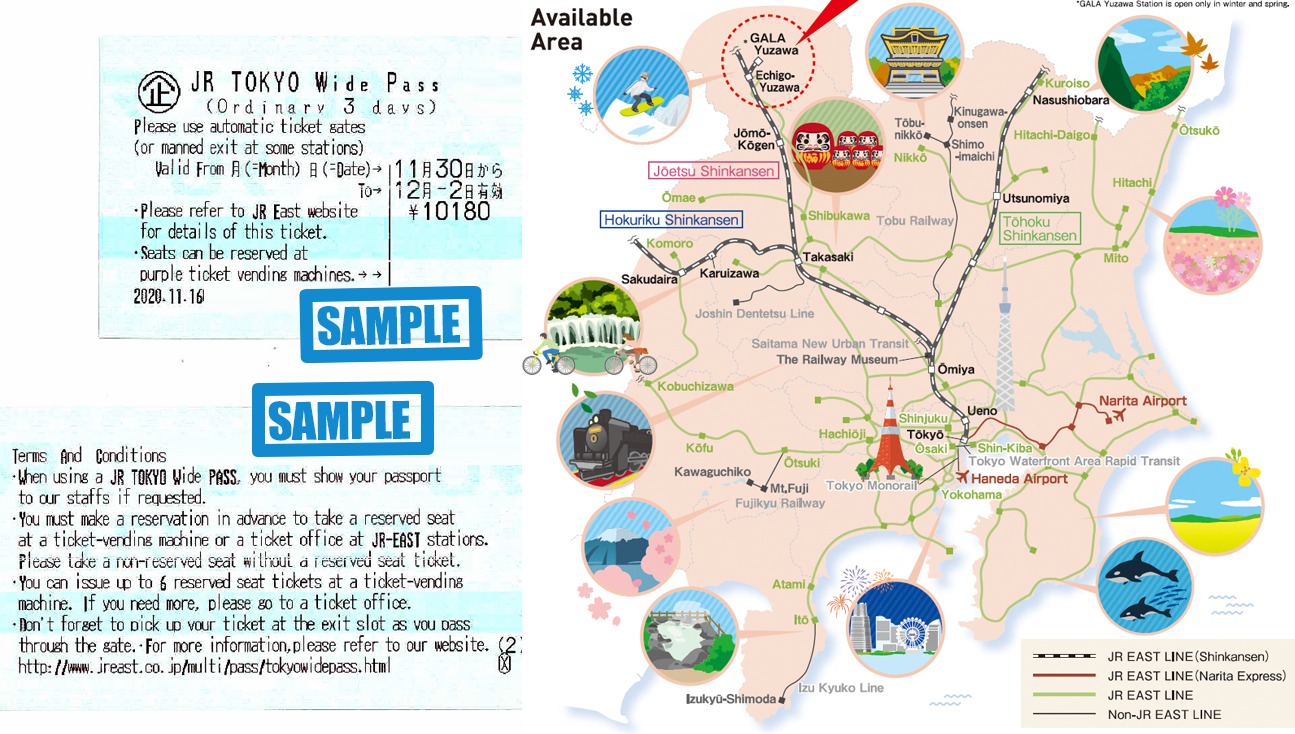
The JR TOKYO Wide Pass and where you can use it. (Image credit: JR East)
If you want to explore the Agatsuma Line and other parts of Gunma, consider the JR TOKYO Wide Pass, an affordable pass that offers unlimited rail travel on JR East lines (including bullet trains) in the valid area for 3 consecutive days. At only ¥10,180, the pass is cheaper than a return train trip between JR Ueno Station and JR Naganoharakusatsuguchi Station (¥11,540).
You can also make seat reservations for bullet trains, some limited express trains and Joyful Trains online for free, up to 1 month in advance, here.
JR EAST PASS (Tohoku area)
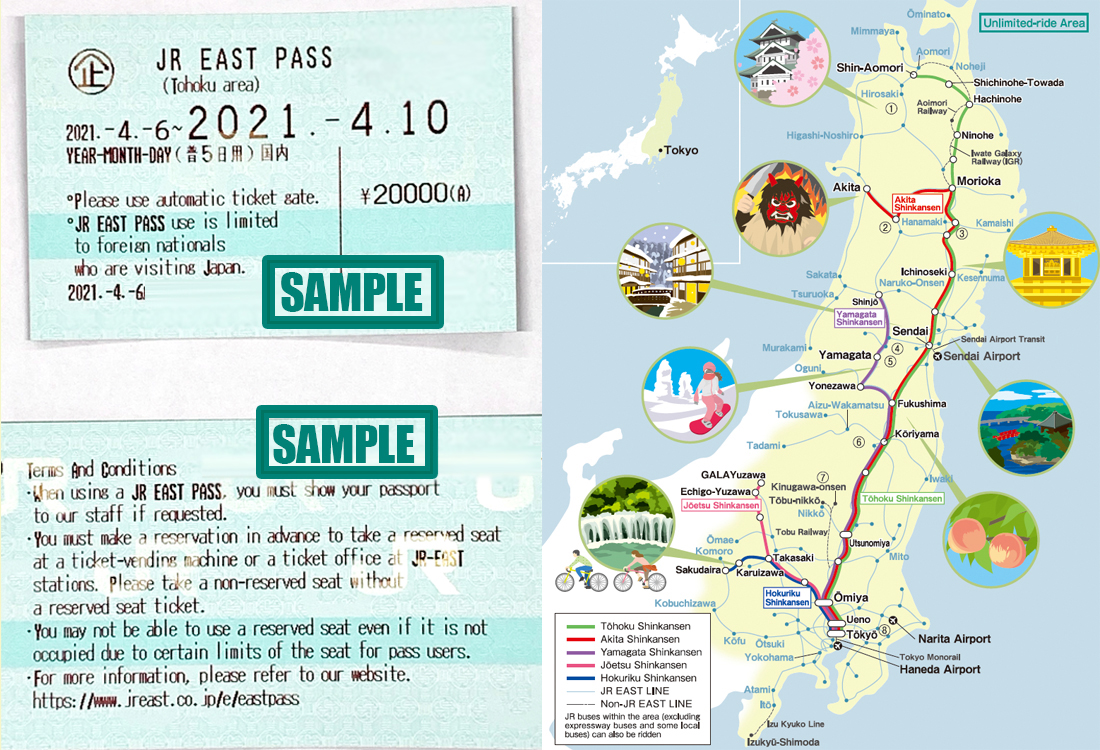
The JR EAST PASS (Tohoku area) and where you can use it. (Image credit: JR East)
Likewise, for those planning to travel to parts of Gunma and other areas in the Tohoku Region, check out the JR EAST PASS (Tohoku area), an affordable pass that offers unlimited rail travel on JR East lines in the valid area for 5 consecutive days. At only ¥20,000, it makes for a great option for railway travellers covering many areas during their trip.
The pass can be used for automatic ticket gates, and foreign passport holders living in Japan are also eligible to use it. You can also make seat reservations for bullet trains, some limited express trains and Joyful Trains online for free, up to 1 month in advance, here.
JR EAST PASS (Nagano, Niigata area)
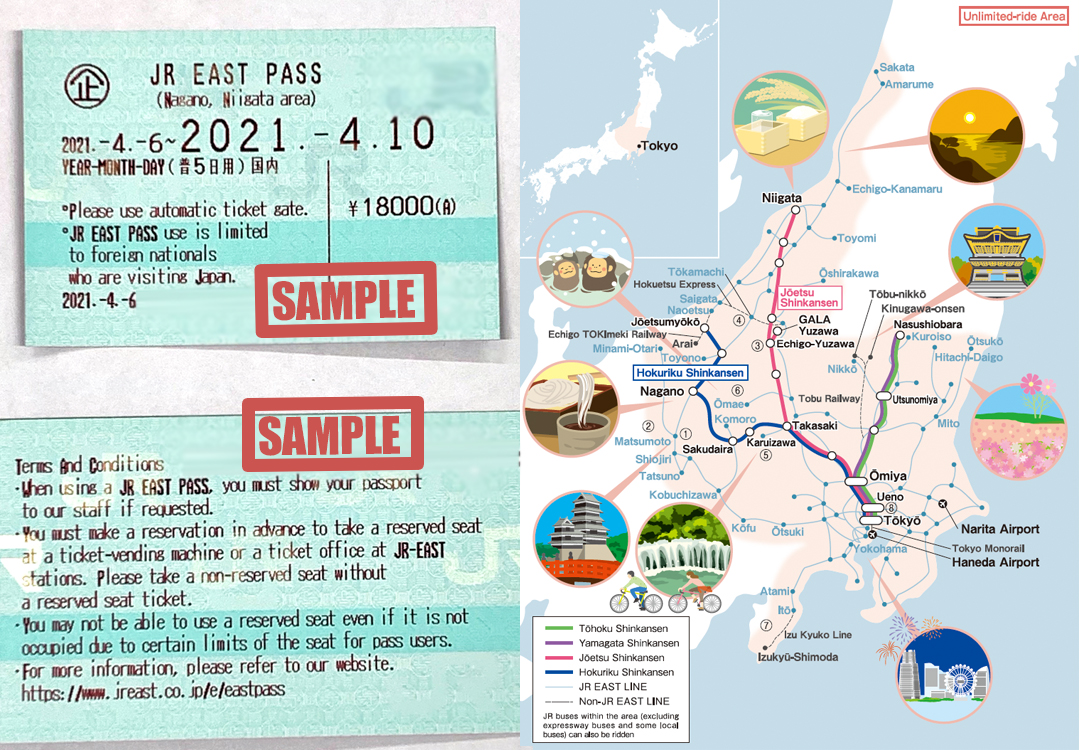
The JR EAST PASS (Nagano, Niigata area) and where you can use it. (Image credit: JR East)
Also, if you plan to travel to parts of Gunma as well as Nagano and Niigata, check out the JR EAST PASS (Nagano, Niigata area), which offers unlimited rail travel on JR East lines (including bullet trains) in the valid area for 5 consecutive days. At only ¥18,000, it makes for a great option for railway travellers covering many areas during their trip.
The pass can be used for automatic ticket gates, and foreign passport holders living in Japan are also eligible to use it. You can also make seat reservations for bullet trains, some limited express trains and Joyful Trains online for free, up to 1 month in advance, here.
Header image credit: ググっとぐんま写真館 (left), ©JNTO (right), illustAC




